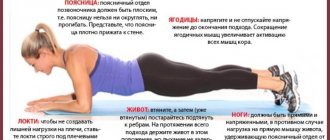Many beginners do not always even know that the program needs to be changed during training. Most people not initiated into the topic of bodybuilding believe that it is enough to develop a program only once and then follow it until the desired mass appears. But this is far from the truth, because the program should be changed.
Then the question arises, causing a lot of controversy - how often should you switch to a new program? There is real confusion here, because someone says that you need to add new exercises several times a month. On the other hand, they say that six months and no less, while others believe that 4 months is the optimal period. Therefore, now we will try to consider the issue from the scientific side.
Why change your training program at all?
Initially, you need to understand why the training is changing at all. This is far from a whim or an action for variety - without changing your training you will not achieve good results. But everyone’s goals are different:
- increase in strength and endurance
- increase in muscle mass
- burning fat deposits
- increase in working weight
For all these points, you will need to switch to a new program over a certain period. And it's all about the fantastic adaptation of the human body. To make muscles grow (read more about how this happens here), you will need to create conditions that are unusual for them, to give them loads that they have not been able to cope with before. For strength training, the technique of constant progression of load comes first.
When you just start working with new weights or exercises, you can say “honeymoon” for muscle fibers. During this period, all the muscles of the beginning athlete actively react to the load and change their characteristics (endurance, strength or other aspects, which depends on the type of training).
When the conditional 30 days are over, the muscles again need to be surprised with something new. This could be increasing the number of sets, reps or weights. Various training principles (superset, pyramid and the like) will also be useful here. But here another question appears.
How to update your training program
This is usually done by adjusting some study parameters. “ In strength training, you can increase the load by changing the weight of the projectile, the time under load, the number of repetitions, and the speed of the exercises,” says Alexey Bolyaev.
In cardio training, you can change the duration of the session, pace and type of load. “Modern fitness offers a large number of cardio formats, and if you change the format itself, it will be good,” explains Ruslan Panov. — Naturally, we will build on individual restrictions on the musculoskeletal system and other systems, and age. But a treadmill, say, can be replaced with an elliptical or HIIT.”
You can replace Zumba with step aerobics (and vice versa), “play” with different styles of yoga, or add Pilates to your training plan.
Does your fitness schedule include different types of exercise (functional, cardio, strength)? For variety, change the order of classes and their duration, this will also create some stress for the body and thereby stimulate progress.
How long does it take for the body to adapt to stress?
The human body is amazingly tuned and able to quickly adapt to new conditions. It only takes 21 days for the brain to turn a daily activity into a habit. As for the muscles, they generally adjust to a new job after several workouts.
An example of such an adaptation would be a situation where an athlete performs a new exercise and the next day moves with difficulty. But after 2-3 workouts, this effect is no longer there; gradually the result of the training is not so physically noticeable. Therefore, the first 2-4 weeks are the most difficult for muscle tissue, when muscles are actively changing. Already at 5-8 weeks the effect slowly decreases, but from 9-12 weeks the muscle simply does not respond to the ongoing training. And this is where you need to create a new stressful situation. If you examine the result on the graph, it looks like this:
It should be borne in mind that this graph and the numbers mentioned are taken from average statistical indicators and can change individually. It all depends on the “starting point”, that is, the degree of training of a person. If we talk only about beginners with up to 1 year of experience, then the numbers are growing, because adaptation is slower due to the poorly developed muscle-brain connection. Therefore, here the process of muscle growth is somewhat extended, for beginners the norm will be 10-16 weeks, only during this period you need to think about changing the training program.
On our website, professional trainers have compiled many training programs for various purposes. A convenient filter system, as well as a unique ability to edit any workout to suit your needs! Go to the training section and select a training program for free!
If we are talking about experienced athletes who fully feel their body and are familiar with pumping and the difference between types of muscle contractions, then they can reduce the intervals to 4-6 weeks of work with an unchanged program. Now let’s look at the recommended periods of work with one PT depending on the level of fitness:
- beginner: 2.5-4.5 months (10-16 weeks)
- average: 2-3 months (8-11 weeks)
- professional: 1-1.5 months (4-6 weeks)
Many people turn to the issue of changing the program only during strength training. But those who use exclusively aerobic exercises (cardio) also need to change it. Here, too, without changing exercises, the body quickly finds a less energy-consuming activity option. Therefore, the weight loss process may stop due to adaptation.
After just 1-2 months on the treadmill, the body will require fewer calories for races. This is all due to the adjustment of all participating processes towards reducing energy consumption. For maximum efficiency, it is recommended to promptly change the loads week by week:
- 1-3 – swimming
- 4-7 – jump rope
- 8-11 – sprint
By the way, many scientists claim that the muscles fully adapt to the loads by the fourth workout. This means that from the 5th workout, the quality response to the load begins to fall. And the further you go, the more noticeable is the decrease in the effectiveness of training.
Why shouldn't you change your training programs often?
Again, the answer will be based on scientific research and conclusions. Many people say that frequently changing training programs is beneficial only because of the constant shock to the muscles. But physiologically it is impossible to shock muscle tissue, because it is completely passive.
If you are not confident in your abilities in drawing up training programs, then the best way would be to turn to professionals! On our website you can order a training plan from professionals taking into account your goals, body characteristics and lifestyle. Receive all necessary comments and support within a month according to the compiled program. Find your coach here
Each exercise has its own schedule for adaptation of the nervous system, which is the reason for the decrease in the effectiveness of the program. Each exercise has its own period of adaptation for the body, because the simplest exercise will become ineffective in just a few weeks, but more complex loads give an effect for several months. Examples include deadlifts and barbell curls. The first exercise will take longer to master by the nervous system, but the second is much faster.
If we take a closer look at the theory of nervous adaptation, then initially there is practically no muscle growth. Only when the nervous system adapts to a new exercise does muscle tissue begin to grow. This is called overcoming a “nervous plateau,” but it should not be viewed as stagnation. Scientists compiled a schedule back in 1988 (Med Sci Sports Exerc., “Neural adaptation to resistance training”).
According to these data, the process of creating the correct neural changes (connection between nerve endings and muscles) lasts 8-20 weeks. Only after this does active growth of muscle tissue begin.
According to the study text, improvements in muscle growth along with strength are associated only with the ability of the nervous system to recruit more muscles to work. Strength training provokes changes in the nervous system, adapting to new loads, which then gives it the ability to better coordinate movements and use more muscles for a certain action. And this causes an increase in net force in a certain direction. As a result, strength increases not because of the growth of muscle tissue, but because of better coordination of their work.
And from this we can already conclude that the planned 4-6 weeks for one program simply does not allow the body to fully use all the muscles. It turns out that strong neuromuscular connections are just beginning to be created, and the athlete changes the training program and, accordingly, the amount of load.
It is also important to include 2-3 basic exercises for a specific muscle group in each workout. Then neural connections are formed better than when using single-joint exercises. Along with this there is one more point.
Why is the benefit of a training program diminishing?
When you begin to train the body, directing the load to muscle training, it experiences an unusual state, in other words, shock and stress, but over time it adapts to the load and stops reacting to it. In other words, muscle volume stops increasing, you remain at a certain level and no matter how hard you try, you cannot overcome it, THE BODY HAS ADAPTED TO THE LOAD AND IT DOESN’T CARE .
VARIOUS EXERCISES REMOVE INDIFFERENCE and act on the muscles from different angles, forcing them to work in all directions, preventing them from getting used to the loads, the adaptation phase is very low, all this leads to achieving new results in increasing strength, growing muscle mass and, of course, losing weight.
Change weight or training program?
As we have already found out, muscles are passive tissues and they do not care what program is currently used. Their destiny is to carry out commands from the central nervous system and nothing more; it will not be possible to deceive them separately from the nervous system. Muscle tissue can only contract and lengthen, nothing else is given. Therefore, only increasing the load can help in this regard.
Use a training diary to plan and record results. In order to comply with the principle of progressive load, you must constantly record your progress and plan your next workouts. Experts have created a convenient and functional training diary - see for yourself!
If you can add a little weight each workout (or through training), then you shouldn’t think about changing your training program just yet. That is, a progressive load allows you to stay longer at one PT. But many people don’t understand this and change exercises on the advice of a friend or a trendy program they see on the Internet. Although in reality, muscles can easily grow even after completing the previous program. At an advanced level, it is worth changing the program only when it is no longer possible to take on more weight. Only then should the athlete think about developing a new training program. Of the standard training schemes, many use the following principles (split training):
- each muscle group 1 time/week,
- each muscle group 2 times/week.
Regardless of this, you can work on one program for a long time and increase weight. And there will be progress, muscle growth will not stop. But when a gradual increase in working weights is no longer possible, then there is no way out and it is necessary to change the program.
At the same time, you cannot increase the number of calories in your diet as your weight increases. If every workout there is progress in the scales, then the number of calories should increase proportionally, otherwise there will be no weight gain. Read about nutrition for weight gain.
To summarize, there is no need to constantly disrupt muscle adaptation by changing the training program; you should definitely get everything that the selected exercises can give you.
When is it necessary to change the program?
In fact, there are 3 main reasons that require a mandatory change to the existing training program.
- Life circumstances . Often life is not built around the gym, but the gym is introduced into the living conditions. If in their youth many people can go to the gym at least every day, then later each person starts a family, begins to build a career and raise children. Then you have to adjust the program taking into account free time.
- Changing the goal . If initially it was necessary to increase muscle mass, and only then it was necessary to remove fat and give relief to the forms, then physically you cannot do without changing the program.
- Boredom . When training stops making you happy and enjoyable, something needs to be changed. Usually the signal is going to the gym “on autopilot” with zero motivation. An excellent option to increase interest in training is to change the program.
What is load periodization
Load periodization (training periodization) is the division of a “global” training plan, aimed at achieving the final goal, into smaller stages.
For example, if a young man who has the most average non-athletic physique with a slight excess of subcutaneous fat wants to look quite “muscular” and at the same time sculpted, then this is his ultimate goal. But in order to achieve this, he needs to increase the amount of muscle mass (and this also requires an increase in strength indicators), and then reduce the amount of subcutaneous fat so that the muscles become visible. All these are different stages, requiring not only a different approach to training, but also compliance with different nutritional systems. Not to mention that the periodization process also implies the presence of recovery periods.
The result of changing the training program
It is hoped that all the information was completely clear and showed the basic principle of changing the program. Now it is clear that the central nervous system cannot adjust in 4 weeks, but requires a minimum of 8 weeks. And it’s clear that the numbers are different for everyone, because a beginner can work with one program for 4 months, progressing, but a professional will find 6 weeks a lot.
Therefore, we are trying to establish an optimal neural connection and get the maximum from the program we use. And only then we consider how it can be improved and modified to transition the muscle plateau. We use the described methods in practice and become closer to our goal - a beautiful, sculpted body.










